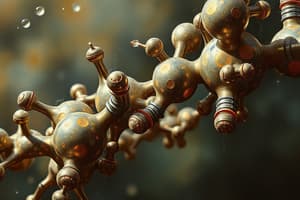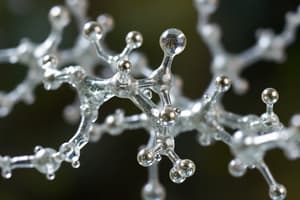Podcast
Questions and Answers
Enzymes are smaller in size than their substrates.
Enzymes are smaller in size than their substrates.
False (B)
Enzymes can be recycled and function in very low concentrations.
Enzymes can be recycled and function in very low concentrations.
True (A)
Enzymes change permanently after catalyzing a reaction.
Enzymes change permanently after catalyzing a reaction.
False (B)
The characteristics of enzymes include shape, specificity, and function.
The characteristics of enzymes include shape, specificity, and function.
The activity of enzymes is unaffected by temperature and pH.
The activity of enzymes is unaffected by temperature and pH.
Flashcards
Are enzymes smaller than their substrates?
Are enzymes smaller than their substrates?
Enzymes are typically larger than their substrates.
Can enzymes be recycled?
Can enzymes be recycled?
Enzymes are not consumed during a reaction. They can be used again and again.
Do enzymes change after catalyzing a reaction?
Do enzymes change after catalyzing a reaction?
Enzymes remain unchanged after a reaction. They can catalyze the same reaction over and over.
What are the characteristics of enzymes?
What are the characteristics of enzymes?
Signup and view all the flashcards
Do temperature and pH affect enzyme activity?
Do temperature and pH affect enzyme activity?
Signup and view all the flashcards
Study Notes
Characteristics of Enzymes
- Composed primarily of proteins, enzymes often require co-factors for optimal activity.
- Function as organic catalysts, significantly increasing the rate of cellular reactions.
- Possess unique attributes including distinct shape, specificity for substrates, and particular functions.
Enzyme Functionality
- Facilitate metabolic reactions at rates that sustain life processes.
- Feature an active site specifically designed for binding target molecules known as substrates.
- Substrates are considerably smaller than enzymes, illustrating the size difference.
Enzyme Interaction with Substrates
- Enzymes interact closely with substrates without being physically incorporated into the end products of reactions.
- Remain unchanged and are not consumed in the process, allowing for repeated use.
Regulation and Environmental Influence
- Can operate effectively in very low concentrations due to their ability to be recycled.
- Highly sensitive to changes in temperature and pH levels, which can affect their activity and stability.
- Enzyme activity can be regulated through feedback mechanisms and genetic controls, ensuring appropriate levels of metabolic activity.
Studying That Suits You
Use AI to generate personalized quizzes and flashcards to suit your learning preferences.




